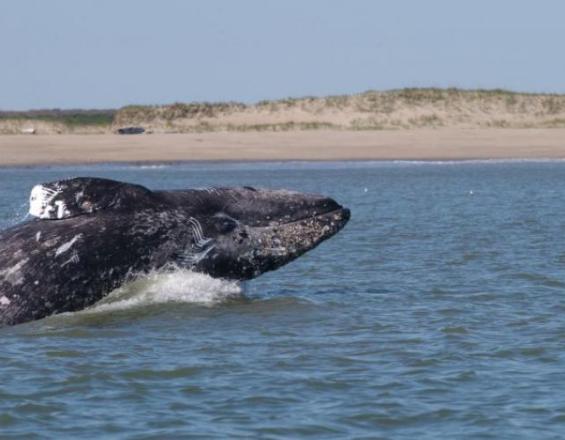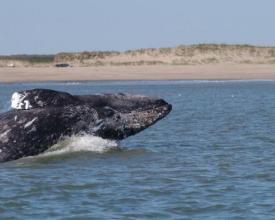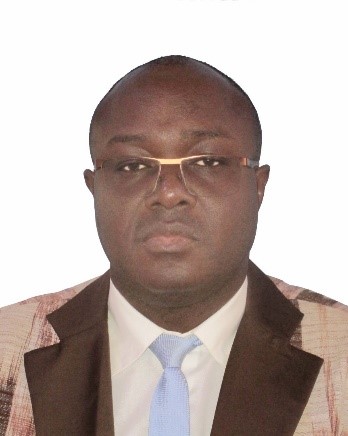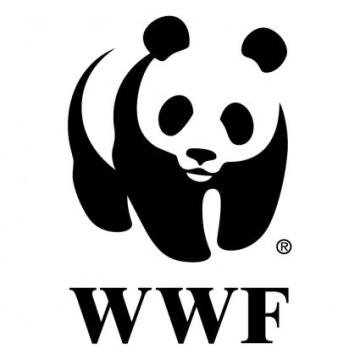
Science-based evidence steers industry action on whale conservation

As the world heads towards a more sustainable future, business and government leaders face challenges on how to reconcile conservation and development.
IUCN-led Independent, Scientific and Technical Advisory Panels (ISTAPs) are helping to address complex and often contentious issues concerning natural resource use. They offer unbiased, scientific advice to reduce a project’s impacts on nature and identify solutions that can contribute to conservation while meeting economic and development goals.
The first ISTAP to be created was the Western Gray Whale Advisory Panel (WGWAP), in 2004. WGWAP provides independent advice to Sakhalin Energy on how to minimise risks associated with its operations on gray whales and their habitat while working with other actors to ensure the whale’s long-term conservation. The whales’ feeding areas near Sakhalin Island, off the Russian coast – a region with large offshore oil and gas deposits – are vital for maintaining the population.
Context
Challenges addressed
As with all of IUCN’s independent panels, there are inherent risks and challenges which require continued vigilance. These include reputational risk from being associated with providing advice on high-impact schemes involving the private sector or large development activities.
Collaboration between business, the public sector and civil society can highlight differences in how institutions approach specific challenges. Relationship development and trust building among these institutions are therefore key. For example, business and academia may have different ideas about the time and resources needed for data collection, consultation, decision making and monitoring.
Other risks include the flexibility of the contracting business or government agency to change its priorities based on any scientific-based evidence, as well as the budget and time needed for the panel to produce conclusions and recommendations.
Location
Process
Summary of the process
All of the key attributes of IUCN’s scientific panels have worked together in the case of WGWAP to ensure a strong foundation for building trust and relationships among a broad group of stakeholders, some of whom have been at loggerheads for years. It takes time to reach a common understanding of controversial issues and a way forward, but WGWAP has built a steady momentum over the years to reach the influence in areas and sectors beyond the original ambition.
Building Blocks
Independence
A structure is in place to ensure the panel is free from any external influence whether from government, private sector, NGOs, scientists or IUCN. Panel members are free to reach what they consider to be the best conclusions and recommendations based on the latest available science. They can be free with their opinions and have no contractual arrangement for research funding or other with the funder/contracting party or any of other companies operating on the Sakhalin Shelf (including their parent or sister companies and subsidiaries).
Enabling factors
The scope of the panel’s work is based on a set of specific, pre-defined conservation and natural resource management questions. Members bring to the table the required expertise from different disciplines and perspectives, and they are expected to consider all evidence before them from a strictly technical or scientific point of view.
Lesson learned
Independence of the WGWAP is central to its ability to serve the function for which it was created, and IUCN helps safeguard the integrity of the panel. On a few occasions, for example, the panel has issued public statements of concern, when it felt necessary.
Transparency
Transparency is critical to building trust between all stakeholders. Information and documentation on the panel process, its working arrangements, reports, conclusions and recommendations, as well as company responses, are made publicly available on the IUCN website, unaltered. Panel members’ names, biographies and the panel’s terms of reference are also published.
Enabling factors
The roles and responsibilities for everyone involved in the panel, as well as its oversight, were clearly defined at the start, including different IUCN stakeholders and the contracting party.
WGWAP meetings are attended by company representatives, technical contractors, scientists, lenders’ representatives, as well as observers from NGOs, government, other companies, local research institutes and others, all of whom can ask questions and provide data and information.
Lesson learned
All of the measures in place to ensure the panel’s independence and transparency have built confidence and trust among stakeholders and credibility of the panel’s operations and findings.
For example, as part of the company’s Monitoring and Mitigation Plan (MMP), an independent observer, contracted by IUCN was present during the the 2010, 2015 and 2018 seismic surveys to develop a first-hand report on the MMP’s implementation and provide any recommendations for improvements in the future. The observer assists the panel and the company in evaluating the effectiveness of the mitigation efforts, providing useful insights to WGWAP, and ultimately the company. Sakhalin Energy is the only energy company operating in Sakhalin that allows the presence of an independent observer as part of its seismic surveys monitoring and mitigation programme, and this is partly due to the long-term collaboration with WGWAP.
Accountability
As with all ISTAPs, measures are in place to ensure WGWAP has a clear purpose, delivers high-quality outputs on time and is managed in a way that is consistent with IUCN’s policies and procedures. A project management structure defines the role and responsibilities of the project manager and other IUCN staff members or units. The panel chair is responsible for managing the panel members, who report on scientific and technical issues. All panel members, including the chair, report to IUCN and have their own terms of reference.
There is a regular monitoring system to verify that the panel is operating in full accordance with the ISTAP principles, that it delivers agreed outputs according to the terms of reference and work plan, and that the stakeholder engagement plan and communications strategy are followed. Based on the work plan, annual budgets are developed by the project manager and, if required under the contract, submitted for sign-off to the contracting party.
Enabling factors
ISTAPs are supported by a grievance mechanism to guarantee that complaints received are addressed in the most transparent, fair and timely manner.
The project manager works with IUCN’s monitoring and evaluation team to verify the integrity of the panel process and its outputs, and to assess the overall impacts of the panel and the potential for broader uptake of its recommendations.
Lesson learned
By establishing a monitoring and evaluation system, IUCN has been able to safeguard the accountability of both the panel and the company. For example, at the launch of the WGWAP Stories of Influence report in 2016, it was reported that out of the panel’s more than 539 recommendations to Sakhalin Energy and other parties, 90% had been implemented or superseded by subsequent advice.
Engagement
The panel works with all relevant stakeholders and affected parties, including the International Whaling Commission (IWC), local and federal government, companies, contractors, fisheries, tourism operators, NGOs, lenders, financial institutions and research institutes. It has a huge network of experts at all levels and takes evidence from a range of disciplines and perspectives.
Over the years the panel has helped ease tensions between the different interest groups by creating an open forum for dialogue, particularly between NGOs and Sakhalin Energy. The organisations that campaigned against the company’s financing now participate as observers in WGWAP meetings.
WGWAP has helped increase the number of arenas where whale conservation is discussed with new regional and national fora being established in the Russian Federation. Close connections have been forged between WGWAP and the IWC which supports a broader, range-wide view of gray whale issues. Several Range States have also adopted a Memorandum of Cooperation on Conservation Measures for the western gray whale that refers to the IWC/IUCN Conservation Management Plan (currently being revised), the IWC and WGWAP.
Enabling factors
The panel’s links with and capacity to engage with such a diverse range of stakeholders has been built up over several years. Trust building takes time, a willingness to take evidence and hear the perspectives of others and the courage to have difficult discussions.
Lesson learned
A key lesson learned through the panel’s engagement has been the importance of understanding and navigating cultural differences be they corporate or institutional, nationality quirks, language or terminology used to describe challenges and solutions.
In addition, while the primary focus of the panel is on Sakhalin Energy, it has also demonstrated the benefits of adopting a more holistic approach to whale conservation and exploring synergies and inputs into national and range-wide processes. This would involve working more closely with the fisheries, shipping and tourism sectors which also impact the whales, and addressing cumulative impacts. Continued discussion among stakeholders is needed to determine whether the panel is the most effective model to take on a significantly wider scope.
Leverage
International exposure and focus on western gray whales due to WGWAP’s work has catalysed other discussion arenas where NGOS, scientists and business people can exchange information. The Russian Government approached the panel for guidance into mainstreaming biodiversity into development and has created several official structures including an interdepartmental working group on gray whale conservation.
In regards to legislation and compliance, the panel would like to see all governments create a level playing field for companies operating in or adjacent to key marine habitats to ensure that conservation is a broader requirement, not just a lender requirement.
Enabling factors
WGWAP was created because of a condition placed on Sakhalin Energy’s lending agreement that the company should work with and take advice from an independent panel of experts. This shows how financial institutions can play a significant role in conservation and are taking an increasing interest in industry’s social and environmental behaviour as seen through mechanisms such as the International Finance Corporation (IFC) sustainability standards.
Lesson learned
The WGWAP process leveraged experts’ knowledge and experience to help safeguard Sakhalin’s gray whales, while providing important lessons for other stakeholders. Sakhalin Energy has also used the recommendations of the panel by working towards best practices, for example, on seismic surveys and oil spill prevention, which in turn has helped to better position itself within the industry and advance conservation globally.
Impacts
- In 2005, Sakhalin Energy altered the route of its pipeline after the WGWAP recommended an alternative that would minimise impacts on the whales’ feeding grounds.
- The WGWAP Oil Spill Task Force helped develop a corporate oil spill response, which was seen as one of the best in the business.
- Sakhalin Energy postponed its large seismic survey for a year in 2009, following advice from WGWAP, and worked with the panel on one of the most complete company-level monitoring and mitigation plans in relation to whale conservation and seismic surveys.
- Subsequent guidelines for effective and environmentally responsible seismic surveys focusing on the protection of whales and other marine species are now being used by practitioners around the world and have informed policy in the US, New Zealand and within the Convention on Biological Diversity.
- WGWAP’s experience has significant potential to influence future developments in other oil and gas regions with important conservation challenges, such as the Arctic. It is also guiding other ISTAPs on controversial conservation and development issues.
- WGWAP’s findings have contributed to the International Whaling Commission, as well as the conservation debate in the Russian Federation and beyond.
Beneficiaries
- Western gray whales
- Sakhalin Energy
- NGOs
- IUCN
- Science community
Sustainable Development Goals
Story
In the early 2000s, there was growing concern over the potential impacts of oil and gas operations on a small population of Critically Endangered western gray whales that fed every summer and autumn off Russia’s Sakhalin Island in the Sea of Okhotsk. When one of the main companies, Sakhalin Energy, sought funding to expand its operations, public outcry reached a crescendo and an unprecedented condition was placed on the loan agreement, requiring the company to take advice from an independent group of scientists.
In 2004, IUCN was called on to convene what is known today as the Western Gray Whale Advisory Panel (WGWAP). More than a decade later, the panel continues to provide objective, independent advice to the company and other actors on the conservation of these whales and their habitat.
One of the first actions agreed in 2005 was that Sakhalin Energy would re-route a pipeline after the panel recommended an alternative route to minimise disruption to the whale’s feeding grounds. Since then, WGWAP has contributed to technical guidance and the development of best practice on a range of issues – from corporate oil spill response plans to seismic survey monitoring and mitigation plans. It has also provided a platform for scientific collaboration, including with government, the International Whaling Commission and civil society.
Importantly, during this time, through collective efforts, the population of western gray whales has increased 3-4% annually, from an estimated 115 animals in 2004 to 174 in 2015. However, the panel has warned that further work is needed to engage other oil and gas operators in the region, as well as other sectors such as fisheries and tourism, to ensure the long-term protection of the whales.
WGWAP has shown that independent science-based panels can turn arenas of potential conflict into spaces for cooperation and even collaboration, and help companies in any sector reduce their impact on ecologically sensitive areas or vulnerable species.


